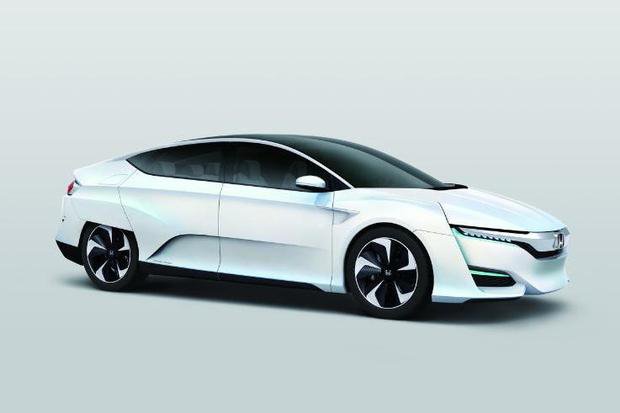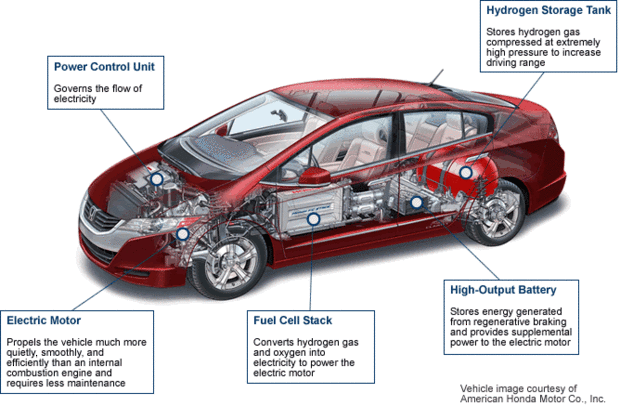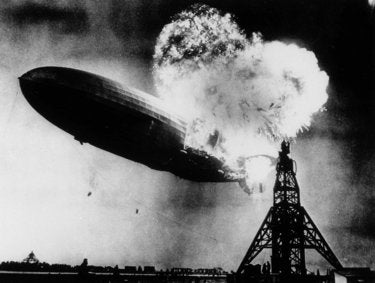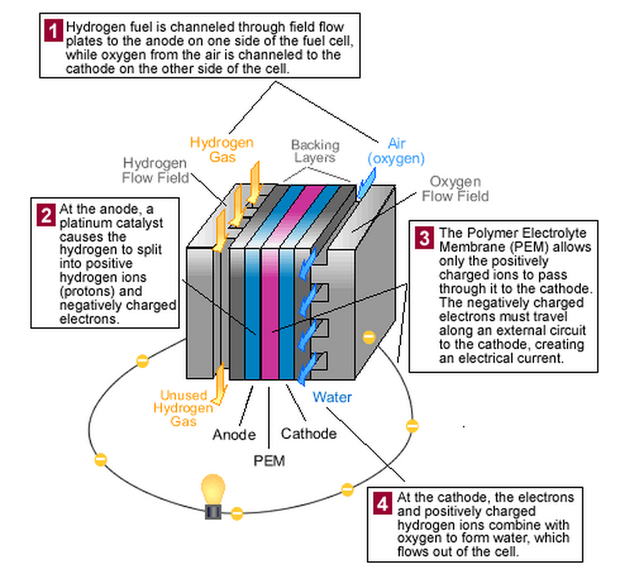http://www.theverge.com/2016/9...int-alstom-innotrans
|




|
Replies sorted oldest to newest
Watch for the news of a spectacular hydrogen fueled train explosion. ![]()
Hydrogen in German mass-transit... What could go wrong?
Jon ![]()
The Hindenburg comes to mind.
And they worry about crude oil trains !!
Hot Water posted:The Hindenburg comes to mind.
There's a little bit of difference in the method of hydrogen storage and volume between this and the Hindenburg.
Rusty
I see the same thought came to many. .. another chance to light the night sky over New Jersey
Hydrogen has been used in engines for a hundred years. It cannot be stored safely. Period.
There are lots of hydrogen motor vehicles on the roads in this country. The only thing holding them back is the lack of a network of fueling stations.
I have an Encyclopedia Britannica film from the 50's that predicted nuclear powered locomotives. Not impossible, just highly improbable, especially when you add the human factor. We've seen derailments because of texting...![]()
The Hindenburg tragedy was the result of static electricity setting the ship's rocket fuel coated fabric alight, not a hydrogen explosion. The hydrogen burned almost completely vertically in that fire and it's cool blue flame was almost entirely masked by the powdered aluminum, iron oxide and fabric burning a hot red-orange. (See the work of Dr. Addison Bain) While the hydrogen contributed to the fire's speed and ferocity, it wasn't what ignited first.
Becky
pennytrains posted:I have an Encyclopedia Britannica film from the 50's that predicted nuclear powered locomotives. Not impossible, just highly improbable, especially when you add the human factor. We've seen derailments because of texting...
Becky
The TGV's in a way ARE nuclear powered. The electricity they use are generated in nuclear power plants!
Dominic Mazoch posted:pennytrains posted:I have an Encyclopedia Britannica film from the 50's that predicted nuclear powered locomotives. Not impossible, just highly improbable, especially when you add the human factor. We've seen derailments because of texting...
Becky
The TGV's in a way ARE nuclear powered. The electricity they use are generated in nuclear power plants!
Which then means they are steam engines ![]()
Hot Water posted:The Hindenburg comes to mind.
It really shouldn't. See below:
Here's why hydrogen-fueled cars aren't little Hindenburgs
Hydrogen is explosive, but supply is a bigger issue for the nascent industry
Honda's new prototype FCV (fuel cell vehicle), which will be available in 2016.

For all the volatility of a gas like hydrogen, which combusts with one-tenth the energy required for gasoline, hydrogen fuel cell vehicles are safer than cars with internal combustion engines, according to industry experts.
At last week's Los Angeles Auto Show, several major car companies, including Audi, Honda, Hyundai and Toyota, announced the release of, or updated plans to release, hydrogen fuel cell vehicles this year or within the next two years.
Toyota touted a four-passenger fuel cell vehicle (FCV) called the Mirai, which will begin shipping next month. Audi unveiled the A7 Sportback H-Tron Quattro, a modification of its four-door Quattro coupe that, instead of a traditional drive train, features an electric motor powered by a hydrogen fuel cell.
Meanwhile, Honda, which already leases its FCX Clarity hydrogen FCV in California, announced another concept vehicle that it plans to release in Japan in 2016. And Hyundai has been leasing its Tucson Fuel Cellsince June and plans to produce 1,000 of the vehicles this year.

Honda's FCX Clarity fuel cell vehicle, which the company already leases in California.
All of the cars are able to fully charge with hydrogen in three to five minutes, compared to the 20 minutes it takes for a Tesla all-electric vehicle (EV) to charge just half way.
A full charge in a Tesla provides up to 265 miles of travel. A Toyota RAV4 EV, gets only 125 miles on a full charge. Hydrogen FCVs, by comparison, can go 300 or more miles on a single charge.
But even though they fill up quickly and can run cars for long distances, hydrogen fuel cells are burdened with a somewhat unfortunate reputation, courtesy of Germany's infamous LZ 129Hindenburg, the hydrogen-filled airship that exploded over Lakehurst, N.J. in 1937.

This photo, taken during the initial explosion of the Hindenburg, shows the 804-ft. German zeppelin just before subsequent explosions sent it crashing to the ground at Lakehurst Naval Air Station in New Jersey on May 6, 1937.
Toyota spokeswoman Jana Hartline said hydrogen fuel cells have gotten a bad rap. The perception that they're dangerous is unwarranted, she argued.
"I think it's just our perception of hydrogen being extremely flammable and dangerous compared to what we're comfortable with in this day and age, which is gasoline," she said. "Gasoline is also an extremely flammable fuel, and one that does not escape like hydrogen."
The hydrogen fuel cell tanks in the Toyota Mirai are pressurized up to 10,000 psi, and hydrogen is 16 times lighter than air. So, if a tank were punctured or otherwise compromised, the hydrogen gas would instantaneously dissipate into the atmosphere, Hartline said.
John Kopasz, a scientist at the Argonne National Laboratory who performs research on hydrogen gas production, said that while there are inherent dangers with any combustible fuel, hydrogen fuel is safer than gasoline.
If a regular car's fuel tank is punctured, gasoline leaks out and pools beneath the vehicle, creating a ready source of fuel for a prolonged burn, Kopasz said.
In fact, in the case of the hydrogen-filled Hindenburg, most of the fire was fueled by diesel fuel for the airship's engines and a flammable lacquer coating on the outside of the dirigible.
Today's hydrogen fuel tanks are also made from highly durable carbon fiber whose strength is assessed not only in crash tests but also in trials in which bullets are fired at it.
Toyota reached back to its roots as a loom manufacturer in the early 20th century to create triple-layer hydrogen tanks made of woven carbon fiber.
The tanks, which are lined internally with plastic, underwent "extreme" crash and ballistics testing, Hartline said, noting that they were "shot with bullets that actually bounced off."
"They had to move to high-caliber armor-piercing rounds to pierce the tank, and even then it had to be shot in the exact same spot twice with an armor-piercing bullet," Hartline said.
The Mirai has other safeguards, including structural integrity to protect the tanks and electronic systems that are programmed to shut down any hydrogen lines in the car if a leak is detected. "So there are redundancies upon redundancies," Hartline said. "We're not going to put anything on the road that doesn't meet our safety, quality and durability standards."
Hydrogen is the simplest and most common molecule known to exist. And because of that, it is a part of almost every other substance, such as water and hydrocarbons. Hydrogen is also found in biomass, which includes all plants and animals.
There are several methods for creating hydrogen fuel, but the most common nowadays is via steam-methane reformation, a process by which high-temperature steam (1,000 degrees Celsius) creates a reaction with methane gas in the presence of a catalyst to produce hydrogen, carbon monoxide and a relatively small amount of carbon dioxide. The carbon dioxide and other impurities are then removed through a process called "pressure-swing adsorption," leaving essentially pure hydrogen. Steam reformation can also be used with ethanol, propane or even gasoline to produce hydrogen.
Steam-methane reformation is most commonly used by oil refineries, which then use the remaining hydrogen to remove impurities, such as sulfur, from petroleum and diesel fuels.
Department of Energy

How a hydrogen fuel cell stack works.
Hydrogen can also be produced through electrolysis, or using electricity and a catalyst to create a chemical reaction that separates the hydrogen molecules from oxygen. Solar power can also be used in combination with water and a catalyst (typically a metal) to generate hydrogen fuel by splitting hydrogen molecules from oxygen. Most often, the catalysts are expensive metals, such as platinum (iridium).
"Making hydrogen from natural gas can be done relatively inexpensively," Kopasz said. "Hydrogen made from water electrolysis is a process we've known about for a very long time, but they're still working to bring the cost of that process down. The main cost now is the electricity, but the catalysts are expensive too."
The biggest challenge to hydrogen production today is cost. While hydrogen molecules may be virtually everywhere, separating them from other compounds can be more expensive than refining gasoline. For example, a kilogram of hydrogen gas contains roughly the same energy as a gallon of gasoline, but it costs more than twice as much to produce, according to Kopasz.
A large part of the cost of hydrogen fuel, however, is the lack of existing infrastructure to produce it. That will change as government programs, such as H2USA, push for the development of more hydrogen fuel resources.
H2USA is a new public-private partnership to address the key challenges of hydrogen infrastructure. Its mission is to promote the introduction and widespread adoption of fuel cell electric vehicles across the U.S.
By 2020, the U.S. Department of Energy believes, the cost of hydrogen used in fuel cell electric vehicles (FCEV) will be competitive on a cost-per-mile basis with the fuels used in other types of vehicles, such as the gasoline in hybrid-electric vehicles.
But, the hydrogen fueling infrastructure is in its infancy. Refueling stations are few and far between. California is expected to build 28 stations by the end of 2016, bringing the state's total to 48 stations, according to Hartline. Toyota has partnered with FirstElement Fuel to build refueling stations in California and with hydrogen fuel provider Air Liquide to build a network of 12 stations throughout Connecticut, Massachusetts, New Jersey, New York and Rhode Island next year.
"The advantage of hydrogen fueling stations is that there's really a global standard that doesn't require specific tooling. Cars will be able to refuel anywhere, all the nozzles will be the same," said IHS analyst Devin Lindsay.
About 5 years ago my son was telling me about hydrogen cells. Not really new. Let me know how it all works out. How much energy does it take to make the hydrogen and water ??
Dominic Mazoch posted:pennytrains posted:I have an Encyclopedia Britannica film from the 50's that predicted nuclear powered locomotives. Not impossible, just highly improbable, especially when you add the human factor. We've seen derailments because of texting...
Becky
The TGV's in a way ARE nuclear powered. The electricity they use are generated in nuclear power plants!
True. Just as electric traction locomotives were coal powered! (Catenary and third rail, not internal combustion. Ha ha, got ahead of that one! ![]() ) I do question the feasibility of maintaining coolant level in a water cooled reactor on anything but perfectly level rail, not to mention dampening the inertia at starts and stops. There is an experimental design these days that uses uranium salts that actually would work.
) I do question the feasibility of maintaining coolant level in a water cooled reactor on anything but perfectly level rail, not to mention dampening the inertia at starts and stops. There is an experimental design these days that uses uranium salts that actually would work.
Using Penny's theory of Electric Power, a lot of our PW Lionels are nuclear powered. A pressurized closed cooling system, like your car has, wouldn't be affected by hills & dales.
What you never heard of the Atomic Pulmore? ![]() (do I "win"?)
(do I "win"?)![]()
It doesn't scare me much outside of large quantities in storage. But the jokes are great ![]()
GG1 glows in the dark: http://images.ulib.csuohio.edu.../press/id/2848/rec/6
Davy, I love your work, But maybe you have been lifting to many stones for your outdoors layout! I will always watch for what you have next!
OK, let's take a H2 powered car, end it to one of those test crash centers, and crash it fully loaded with fuel!
Now, I have though that a leak from a high pressure vessel is not a good thing....!
Hydrogen powered fuel cell vehicles have been on the road for many years. They are currently available from several manufactures. What is holding them back is a lack of hydrogen gas stations and questionable economics. The reason they are being sold is the manufactures get big carbon credits for these cars, which are used to balance off against the highly profitable, but dirty, SUVs. They pass crack tests just fine. The only recommend changes is the garage vents need to be moved from the floor to the ceiling.
The real future is probably with electric vehicles as so many auto trips are only a few miles from home. Currently there is work going on is so the utilities will use your cars battery to supplement the electric grid in the early evening when demand is up and the solar panels are not providing power. Then late at night the battery will be recharged.
Railroad electrification does not appear to be in the near future as the cost is so high.
There have been many propane and natural gas vehicles in use regularly for more than just a few decades seemingly without much issue. The tanks for those were strapped into the trunk and can be swapped out (1980s lol) I had a propane jetted carburetor and regulator for a 60s 1500cc type1VW motor.
I'll admit it took me awhile to be comfortable with the tanks too, but I felt fine about them after I saw two totaled from the rear at a junkyard I didn't see a dent in the tanks and the saftey mechs worked. (1980s Lifeboiy LTD (looks like a bar of soap))
Its not nitroglycerin, I ain't scared. I'll probably get run over by a bus anyway
(Many also use "gasses" ![]() )
)
Is gasoline safer than hydrogen in a car crash? I daresay some research has gone into engineering hydrogen tanks to withstand crashes and maintain acceptable safety standards.
Ace posted:Is gasoline safer than hydrogen in a car crash? I daresay some research has gone into engineering hydrogen tanks to withstand crashes and maintain acceptable safety standards.
Probably less safe, a punctured gasoline tank will leak fuel that will pool and run, looking and waiting for an ignition source, and it can be Very Patient in that wait. Spilled gasoline can soak a responder, or victim's clothing, keeping a potential flame in CONTACT with a person.
A Hydrogen tank ruptured in an accident will dissipate (upwards) into the atmosphere, and not soak a person creating an additional danger.
I can't believe how many here have never watched a movie, Hollywood would be LOST, without EXPLODING GAS TANKS![]() , while not as common, and rarely as spectacular as Hollywood portrays, gas tanks DO, Explode and/or burn in the real world, that is NOT WATER in that tank.
, while not as common, and rarely as spectacular as Hollywood portrays, gas tanks DO, Explode and/or burn in the real world, that is NOT WATER in that tank.
AS has been stated several times already, the Hindenburg, gave Hydrogen an undeservedly bad reputation, that it doesn't deserve( kinda like Lionel's CW-80 Transformer, Some people wont forget EARLY troubles![]() ) People have just gotten used to gasoline and it's potential and accepted it, and we have developed safety standards for it's handling, just as safety standards have been, and will continue to develop for BOTH types of fuel(think Ford Pinto
) People have just gotten used to gasoline and it's potential and accepted it, and we have developed safety standards for it's handling, just as safety standards have been, and will continue to develop for BOTH types of fuel(think Ford Pinto![]() ) Safety standards are always evolving in all parts of our lives.
) Safety standards are always evolving in all parts of our lives.
If Hydrogen were to become Financially practical and Accepted, The economic and environmental advantages would be incredible, moving our highway fuel production HERE, both producing more jobs HERE, and reducing our dependence on foreign oil, and emitting water vapor for exhaust.
Is it possible that the Oil companies don't want people to learn about and accept Hydrogen as a fuel source?
Doug
Hydrogen is less explosive than gasoline , or more importantly, gasoline vapor. Years ago they did a story on the PBS show "Nova", where they had a gas can full of gasoline/gasoline vapor and a can full of hydrogen gas, and they fired tracer bullets into them. The gasoline can blew up with the force near that of a stick of tnt, the hydrogen simply burned with a clear flame (that was one of the science goofs in the movie "the Martian", if he burned hydrogen to produce water it would have burned clear, not yellow, but looked better as yellow in the movie). I have seen anti hydrogen articles and films out there, and they all show the Hindenberg, which has been proven time and again, including on mythbusters, that it was the coating on the fabric (basically the equivalent of the butylene dope they used on the old WWI biplanes and as kids we did on flying model airplanes, the ones with the balsa frame and tissue paper wings).
You can run hydrogen in a standard gasoline engine pretty easily these days, wouldn't even be as rough as it was with carbs, thanks to the engine management systems, you can program them to run on hydrogen pretty easily (I saw a video of a BMW 5 series running on hydrogen, the big conversion was in the tanks to store the hydrogen and the lines to get the hydrogen to the engine, the rest involved programming the ECU). Fuel cells mix hydrogen and oxygen with a catalyst to produce water, which also generates electricity (it is the reverse of electrolysis, which uses and electric current to spit water, chemical reactions are generally two way like that).
There are several problems with hydrogen, but it is not impossible:
1)Current methods of getting hydrogen are energy intensive. You can electrolysize water, which is relatively inefficient (in theory you could use solar or wind power to power it), but in the end likely won't be practical on a large scale.
2)get it from natural gas, which has its own problems (the same as any fossil fuel, you extract the hydrogen from it, what do you do with the carbon that comes out of it? Likely, they would allow it to form co2 and escape, not a good thing. If they could get it as solid carbon, might be able to do something with it, like make carbon fiber).
3)Modify algae to use photosynthesis to produce hydrogen, which already can be done in the lab. If it let co2 escape, wouldn't be a problem, because the algae took co2 out of the air to start the process, net zero add. Problem here is can it be done commercially, if it could you could use the modified algae to create hydrogen while breaking down human wastes, kind of a win win.
Then you have the next big one, distribution, right now gasoline is delivered to stations in trucks. In theory you could modify a gas station to take liquid hydrogen or compressed hydrogen, and use natural gas pipeline technology to deliver it to terminals, but would be a pretty costly thing to do (it is feasible).
And of course, overcoming the propaganda. If they produce hydrogen using algae, the natural gas and oil producers aren't going to be happy, for obvious reasons, and you can be certain all the fear mongering would be out in full force, pictures of the hindenburg and so forth , and people will likely believe it, and if you tell them gasoline is more explosive, they will ignore it.
Diesels could run on hydrogen, the way they run on CNG today (they have buses running on that), but I don't know how practical it would be, if they would need to refuel more.
Fuel cells are likely the cleanest form of hydrogen use, you get water out of it, burning hydrogen likely would produce other pollutants, like NOx, and you would still need things like catalytic converters if you burn it.
Petroleum still has a smallest overall eco footprint as of today. Why? The manufacturing, availability, and disposal of the things used in the alternatives also needs considering. The electricity for electrics, the battery chemicals, etc. etc..
Why the push for alternates if petrol is so great? We have to start somewhere, sometime, before it's gone ![]() IMO, hydrogen is one of our best options.
IMO, hydrogen is one of our best options.
Legacy hydrogen?
Access to this requires an OGR Forum Supporting Membership
